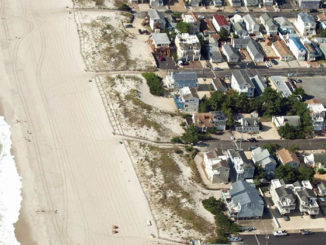
NEW JERSEY—A new Energy Master Plan that includes seven key strategies and a greenhouse gas reduction plan to make New Jersey 100% reliant on “clean energy” by 2050 was put into motion by Gov. Phil Murphy Jan. 27 in a statewide effort to shift away from energy production that contributes to climate change.
Murphy signed executive order No. 28 to direct the state Board of Public Utilities, along with other state agencies, to develop a statewide energy plan.
Moreover, Murphy also signed executive order No. 100 to direct the state Department of Environmental Protection to implement regulatory reforms to reduce emissions and adapt to climate change.
“With this executive action, New Jersey is the first state in the nation to pursue such a comprehensive and aggressive suite of climate change regulations,” said Murphy in a statement.
“New Jersey faces an imminent threat from climate change, from rising seas that threaten our coastline to high asthma rates in some of our most vulnerable communities due to fossil fuel pollution,” said Murphy.
“Successfully implementing the strategies outlined in the Energy Master Plan will drastically reduce New Jersey’s demand for fossil fuels, reduce our carbon emissions, greatly improve local air quality, and related health impacts,” added Murphy.
50 percent ‘clean’ by 2030
The 290-page plan lays out a vision for New Jersey to attain its green energy goals: 50 percent by 2030 and 100 percent clean energy by 2050.
Murphy noted a recent Rutgers University report that found sea levels along the state’s coastline predicted to rise by one foot by 2030 and two feet by 2050.
Speaking to reporters, Murphy said the projected impacts of a rising sea level are ominous to a future Jersey Shore. “We are not going to let this keep happening without a fight,” he added.
While the plan received generally high marks from legislators, Republicans said the plan did not address potential costs to taxpayers.
Moreover, an academic policy expert said the plan needed to be thoroughly analyzed for economic impacts, such as increased taxes, job gains and losses, and effects of other states’ greenhouse gas impacts on New Jersey.
“For a start, the state should conduct a complete, and the word complete cannot be emphasized enough, energy rate impact of its Energy Master Plan (EMP) that includes all of the additional costs (e.g., transmission, tax incentives, state expenditures, etc.) that the plan imposes,” wrote Frank A Felder, director, Rutgers University’s Center for Energy, Economic and Environmental Policy.
‘Impact analysis’ needed
“The state also should perform a comprehensive economic impact analysis of the EMP that determines the reduction in employment and gross state product due to higher energy costs. The state’s clean energy analyses should undergo an independent and objective peer review process” before implementation, Felder added.
The master plan proposes seven key strategies for reducing greenhouse gas emissions, including: increasing electric vehicle usage, improving energy efficiency standards, developing offshore wind and expanding solar power, modernizing the state’s energy distribution system, and reducing energy consumption and emissions from the building sector.
One key first for the master plan is the plan prohibits state agencies from signing off on a proposed building project if it does not conform with state strategies to minimize climate change.
According to online sources, the state gets 94 percent of energy from natural gas and nuclear power, two sources that most environmental groups are pressing the state to eliminate.
The new master plan allows both nuclear power and natural gas as “carbon-neutral” or clean sources of energy, provided the natural gas plants take action to minimize and offset their carbon emissions.
Jeff Tittel, director, Sierra Club New Jersey chapter, opposed the new plan because it does not call for a moratorium on new fossil fuel projects and he believes the plan will not get the state to zero carbon by 2050. He said the plan “defines clean energy to include incinerators, natural gas, biogas and others” which he opposes.
State officials said it’s too soon to estimate how much the changes outlined in the plan might cost taxpayers in the state. Republicans warned that New Jerseyans may see their energy rates go up.
Praise from advocates
“Gov. Phil Murphy, the greenest governor in the country, is putting New Jersey at the forefront of climate action by requiring developers to consider the environmental impact before they build,” said Ed Potosnak, executive director, New Jersey League of Conservation Voters.
“This unprecedented, first of its kind action is sending a clear and hopeful message to the people of New Jersey that despite the lack of leadership in Washington, our state is committed to protecting our families, public health, and economy from the impacts of climate change,” said Potosnak.
Doug O’Malley, director, Environment New Jersey, said the master plan, with its carbons regulations and increased state DEP regulations, “should provide a road map on how we can start reducing emissions from fossil fuels…this commitment by the Murphy administration is significant and provides a sea change in the regulatory thinking of DEP,” he added.
Under state law, New Jersey updates its energy master plan every few years and last updated it in 2015, following the impacts of Superstorm Sandy in 2012.



